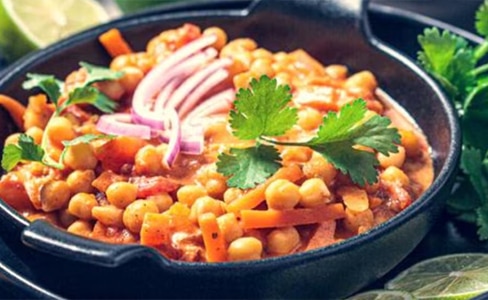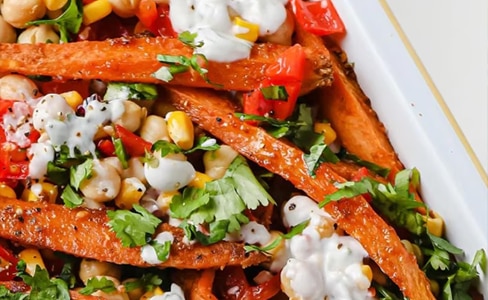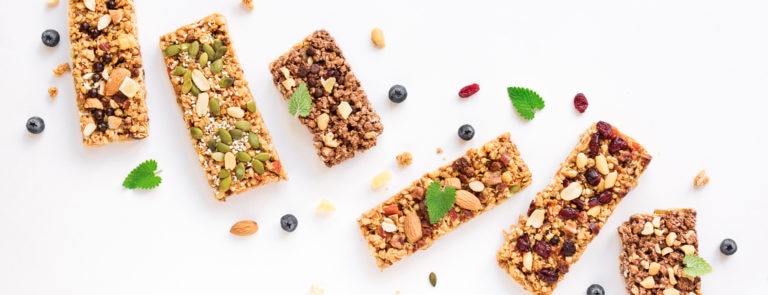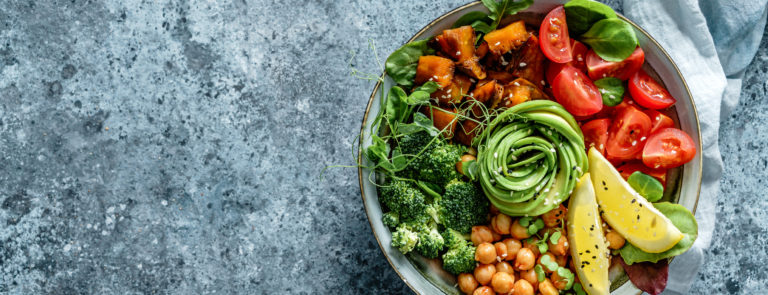20% off €35
Chickpeas for iron, protein, and fibre
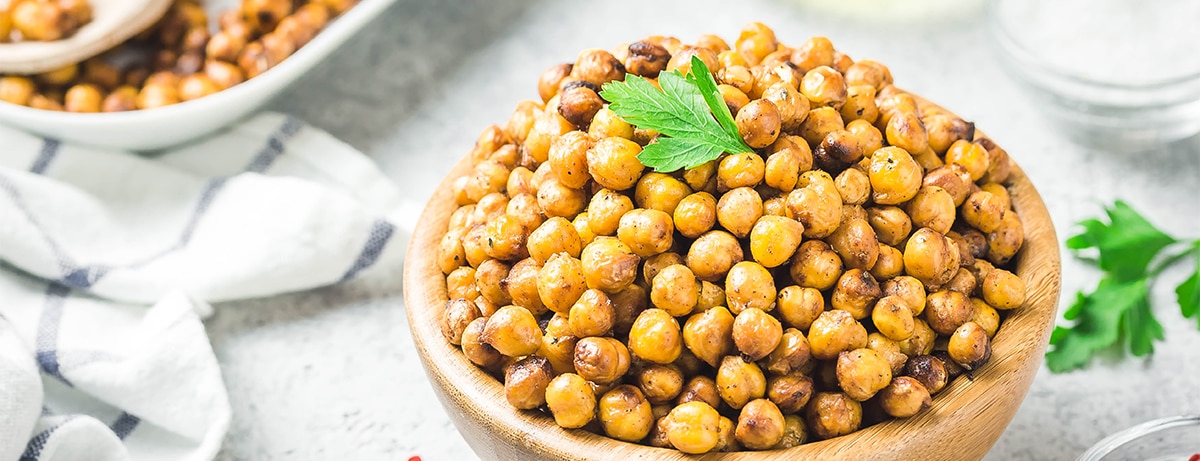
What are chickpeas?
As far back as 3500 BCE, chickpeas have been a staple food for many diets and cuisines worldwide. Also known as garbanzo beans, these tasty legumes originated in the Mediterranean and the Middle East but are now a common feature in dishes all over the globe.
Keep reading to find out all about chickpeas, how they might benefit you and easy ways to add them to your diet.
Skip to: What are chickpeas? | Why are chickpeas good for you? | Benefits | Side effects | How to cook | Easy chickpea recipes | The bottom line
What are chickpeas?
Chickpeas are a wonderful source of protein, iron and fibre and are one of the main ingredients for hummus, curries and more. Part of the legume family, which also includes kidney beans, black beans and more, chickpeas are a type of pulse – the edible seeds within the pods of certain types of legumes.1
The most common type of chickpea is one that you’ll have likely seen on the shelves of many food shops. They are round and have a light beige colour, however, there are lots of other varieties of chickpeas that can be black, green, and even red.
Why are chickpeas good for you?
Why are chickpeas good for you?
Chickpeas make a great addition to a healthy, balanced diet as they are packed full of essential nutrients, healthy fats and have a low glycaemic index (GI). They have a moderate number of calories too at around 164 calories per 100g.
As a result, the nutritional value of chickpeas is high, and it’s thought that the health benefits of chickpeas are vast too - like helping to manage your weight, your heart and gut health.
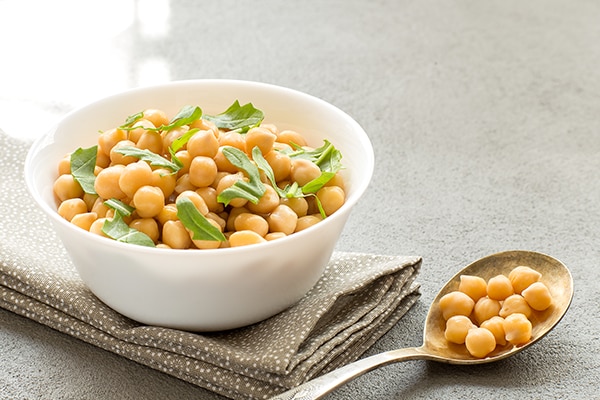

4 potential nutritional and health benefits of chickpeas
- A source of plant-based protein
Protein is known as the building block of our bodies, and we need protein in our diets to maintain and repair our muscles and body tissues.6
Studies have shown that a diet that is high in protein can keep hunger at bay as well as help us to build muscle and control our weight. With 9g of protein in every 100g, cooked chickpeas are a valuable addition to a meat-free diet.4
- Full of iron
Prized for their high vitamin and mineral content, chickpeas are a vegan-friendly, dietary source of iron.7
Eating enough iron is essential for keeping our blood healthy and producing red blood cells. This is particularly important for women, who need higher amounts of iron due to their menstrual cycles.9
Eating enough iron is also essential for vegans and vegetarians, as most iron-rich foods are sourced from animals.10
- Rich in Vitamin B
A form of folic acid, vitamin B or folate, plays a key role in forming new cells which makes it essential for pregnant women. Not having enough folate before or during pregnancy has been linked to birth defects in unborn babies, so it’s important to consider this when pregnant.11
It’s thought that just one tin of chickpeas will provide you with most of your recommended daily allowance of this vital nutrient.4
- Packed with fibre
Packed with fibre According to current NHS guidelines, most of us should aim for at least 30g of fibre a day. While most of us fall short, 100g of boiled chickpeas contains 8g of fibre.4
Research shows that the fibre and other nutrients found in chickpeas are so important because they could help lower the risk of developing conditions like heart disease.13,14
Possible chickpea side effects
Gas and bloating are the most common side effects of eating chickpeas, likely because your body finds them hard to digest and their large concentration of fibre. Increasing your fibre intake too quickly can upset your stomach, leading to gas and bloating, so it's best to introduce chickpeas to your diet slowly.16
If you’re using a can of chickpeas, you can rinse them thoroughly after draining the can to help stop bloating, and if you’re using dry chickpeas, you can soak them overnight to remove the natural compounds in pulses that can trigger gas and bloating.17
You can also be allergic to chickpeas and other legumes, so if you experience any allergy symptoms after eating chickpeas, like vomiting or itchy skin, you should stop eating them immediately and seek help from a medical professional.18
Chickpeas can also interfere with certain types of medications, as they can contain large amounts of potassium (especially canned chickpeas). So, it is best to make sure you’ve checked with your GP that chickpeas are safe for you to eat if you are currently taking medication.19
How to cook chickpeas
Eaten hot or cold, chickpeas are a versatile addition to any kitchen cupboard. Great as an ingredient in many meals, chickpeas can be eaten on their own as a great snack, or you can find many chickpea products, like chickpea crisps or chickpea flour, on the market.
Try some of these recipes to enrich your diet with protein, iron, and fibre:
Homemade hummus
Homemade hummus
There’s no need to buy a tub from the supermarket when it’s so simple to make hummus at home. A tasty dip with carrot and celery sticks or as a moreish starter with strips of pitta bread.
Simply combine chickpeas, lemon juice, cumin, tahini, and garlic in a blender. Mix to form a creamy texture, adding water along the way if the mixture is too dry.
Season with salt and pepper and drizzle with olive oil to serve.
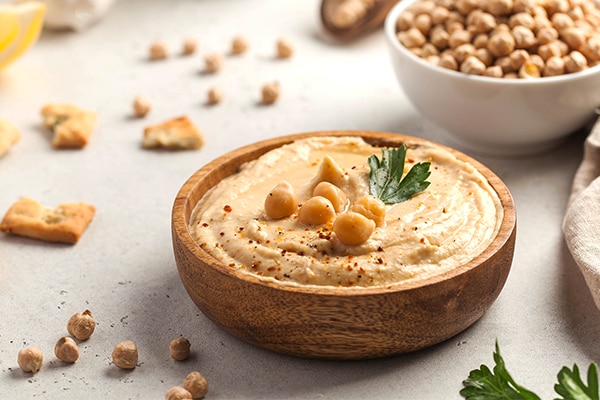

Delicious baked falafel
A delicious baked version of these deep-fried Middle Eastern falafels is delightful.
To make, thoroughly mash together cooked chickpeas and sautéed onion and garlic. Add coriander, cumin, and a beaten egg. Mix and season with salt and pepper to taste.
Split the mixture into small balls and bake in a preheated oven for 20 minutes on a non-stick baking tray. Once they’ve cooled, serve them with shredded lettuce and minted yoghurt.
For an egg-free alternative, try vegan eggs!
Straightforward channa masala
Straightforward channa masala
Chickpeas, or channa as they’re called in India, are fantastic in curries. Although it’s straightforward to make, channa masala is packed with flavour.
Add onions and garlic to an oiled pan with cumin, turmeric, coriander, and a pinch of chilli powder.
Once the onions are browned, add the chickpeas and a few tablespoons of water. Simmer for 15 minutes before seasoning with salt and lemon juice and you have yourself a delicious chickpea curry.
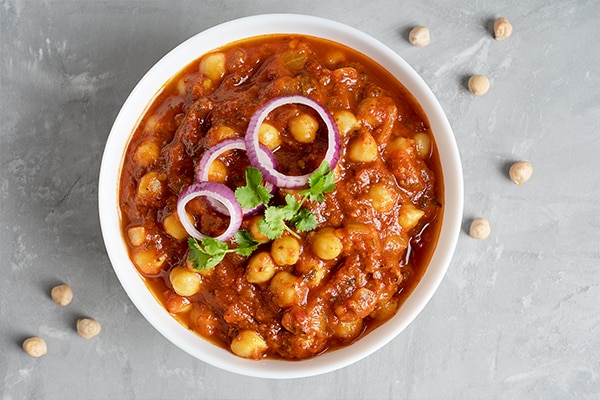

Crunchy roasted chickpeas
Roasting chickpeas in an oven provides a crunch, handy snack. Spread boiled chickpeas onto a non-stick baking tray.
Sprinkle with your favourite spices and a drizzle of oil and roast in the oven until they turn golden. Let them cool for a healthier alternative to crisps.
For a sweet treat, swap the savoury spices for cinnamon, vanilla, or honey!
Easy chickpeas recipes
From hummus and salads to curries and more, there are so many delicious chickpea recipes for you to try. Why not check out more of our favourite chickpea recipes here on the Health Hub?
The bottom line
Whether you call them garbanzo beans, channa or chickpeas, it’s clear that regularly eating these legumes is a great way to boost your diet with essential nutrients.
Chickpeas are an excellent addition to any balanced diet as they may offer a lot of health benefits that can help you feel great and improve your overall well-being.
With their high protein content, fibre, and iron, chickpeas are a delicious and nutritious snack that can help you feel full and maintain a healthy lifestyle.
So, next time you're looking for a yummy and healthy snack or looking to bulk up the protein in your favourite recipe, consider grabbing some chickpeas!
1. https://www.hsph.harvard.edu/nutritionsource/food-features/chickpeas-garbanzo-beans/
2. https://www.britannica.com/plant/chickpea
3. https://www.ncbi.nlm.nih.gov/pmc/articles/PMC5188421/
4. https://fdc.nal.usda.gov/fdc-app.html#/food-details/173757/nutrients
5. https://www.mdpi.com/2072-6643/12/12/3678
6. https://www.hsph.harvard.edu/nutritionsource/what-should-you-eat/protein/
7. http://www.dailyiron.net/chickpeas/
8. https://www.nhs.uk/conditions/vitamins-and-minerals/iron/
9. https://pubmed.ncbi.nlm.nih.gov/36706856/
10. https://www.ncbi.nlm.nih.gov/pmc/articles/PMC3999603/
11. https://www.medicinesinpregnancy.org/Templates/Pages/BumpsPIL.aspx?id=97949&epslanguage=en&print=y
12. https://www.nhs.uk/live-well/eat-well/digestive-health/how-to-get-more-fibre-into-your-diet/
13. https://www.heartuk.org.uk/low-cholesterol-foods/fibre-
14. https://www.ncbi.nlm.nih.gov/pmc/articles/PMC5731843/
15. https://www.healthyfood.com/advice/the-facts-on-farting/
16. https://newsinhealth.nih.gov/2010/08/rough-up-your-diet
17. https://www.health.com/nutrition/are-chickpeas-healthy
18. https://www.allergyresources.co.uk/Chickpea.php
19. https://www.nhs.uk/conditions/anticoagulants/considerations/

